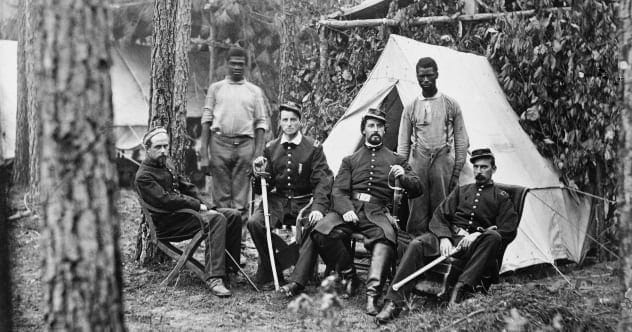The American Civil War was exceptionally brutal, resulting in immense loss of life. It occurred during a violent period, marked by the adoption of guerrilla warfare, rifled weapons, and repeating firearms, yet predating modern medical standards and antibiotics. This combination led to maximum casualties with minimal chances of recovery.
More Americans died in the Civil War than in any other conflict in the nation’s history. The suffering caused is well-documented, as are the paranormal tales that have emerged. The Civil War remains an eerie and unsettling topic, filled with stories, both real and supernatural, that continue to chill. Here are ten such stories:
The Taste of Brains
Soldiers often kept diaries during their deployment, whether as personal journals or letters to loved ones. Henry Fitzgerald Charles, serving with the 21st Pennsylvania Cavalry, chronicled his experiences in the Union Army. He participated in numerous conflicts and witnessed the war’s horrors firsthand. One incident stood out.
Charles wrote about a time after a battle when he and another soldier searched the woods for salvage. While resting, Charles recounted, “All at once I heard a gun crack, and at the same time, my mouth was filled with another man’s brains. There was a sharpshooter in the distant woods somewhere… I reckon he waited till he had us both in line and was going to kill two birds with one stone, but my friend’s head was too hard—it reflected the bullet. If I swallowed any of it, it certainly came up along with everything else I had in my stomach.” A bullet aimed at both men was deflected by his friend’s skull, leaving Charles with a gruesome taste.
The Devil’s Den, Gettysburg
The Devil’s Den, a rocky hill in Gettysburg, Pennsylvania, gets its name from the twisting passages among its large boulders, which some believe were created by a giant serpent, referencing the biblical Devil. This small hill is known for numerous ghost stories and alleged sightings. Visitors often report that electronics malfunction randomly. Some claim to see uniformed Union soldiers walking through the area, including one with a bloody chest wound asking for help.
The hill saw intense battle on the second day of the Battle of Gettysburg, the bloodiest battle of the Civil War, itself the bloodiest conflict in American history. If ghosts exist, Devil’s Den would be a likely place to find them.
Angel’s Glow
Many soldiers reported that their wounds would sometimes glow blue, notably at the Battle of Shiloh. Those whose injuries glowed seemed more likely to survive. This light became known as Angel’s Glow.
For a century and a half, the glow was dismissed as superstition. A 17-year-old, whose mother studied bioluminescent bacteria, connected the dots. He and a friend conducted experiments and discovered that the light was caused by the bacterium Photorhabdus luminescens. To soldiers who knew nothing of microbiology, this must have been an otherworldly experience.
Green Eyes
Soldiers told stories of Ol’ Green Eyes, a supernatural creature haunting the site of the Battle of Chickamauga in Tennessee and Georgia. Descriptions of the creature vary: sometimes a giant white ghoul, other times a green-skinned swamp creature with fangs, and sometimes a headless soldier searching for their head. Common to every version are bright, glowing green eyes (yes, even the headless soldier). The area is unsurprisingly haunted, given that over 34,000 soldiers died there in just three days.
The Dream of John C. Calhoun
John Calhoun, an American politician who served as Vice President under John Quincy Adams and Andrew Jackson, was known as the ‘cast-iron man’ for his staunch support of Southern customs, including slavery and white supremacy. A few years before the war, as Calhoun prepared a plan for the South to secede, he had a dream.
Calhoun recounted, “The sight struck me like a thunderclap. It was the face of a dead man whom extraordinary events had called back to life. The features were those of George Washington and he was dressed in his General’s uniform.” Washington placed a black spot on Calhoun’s right hand, stating, “is the mark by which Benedict Arnold is known in the next world.” Washington warned Calhoun that dissolving the Union would be traitorous and would haunt him eternally.
St. Peter’s Ghost
St. Peter’s Church in Harper’s Ferry, West Virginia, served as a hospital during the Civil War, caring for soldiers from both sides. Both armies avoided attacking it. The church is said to be haunted by a young soldier who died in its doorway.
The young man, wounded, pleaded with nurses to attend to him. They prioritized others with seemingly more severe injuries. The soldier waited in front of the church. Finally, as they carried him inside, he died just as he crossed the threshold, whispering, “I’m saved.”
Champ Ferguson
Most Southern men who supported the Confederacy enlisted as soldiers. Champ Ferguson took a different path. He formed his own unit of friends and neighbors, acting solely under his command. They conducted guerrilla attacks on whomever Ferguson chose.
They routinely attacked and killed civilians believed to support the Union, often targeting the wounded, elderly, and sleeping. Some reports claim Ferguson mutilated his victims’ bodies. After the war, he admitted to killing over 100 men and was hanged for war crimes.
Andersonville Prison
Champ Ferguson was one of two men executed for war crimes during the Civil War. The other was Captain Henry Wirz, commander of Andersonville Prison, or Camp Sumter. Over 13,000 Union troops died there from starvation, dehydration, and disease.
Conditions were atrocious and inhumane, resembling those of Nazi concentration camps. Dysentery, scurvy, and typhoid fever decimated the POWs, killing an estimated 100 per day. Survivors described constant cruelty and suffering, believing the prison to be Hell.
Washington Again
Colonel Joshua Chamberlain and his 20th Maine Infantry Regiment famously charged down Little Round Top at the Battle of Gettysburg, preventing a Union loss. Many soldiers claimed to have seen the ghost of George Washington, in full Revolutionary War regalia, giving the order to charge.
Chamberlain later said, “I have no doubt that it had a tremendous psychological effect in inspiring the men. Doubtless, it was a superstition, but who among us can say that such a thing was impossible? We have not yet sounded or explored the immortal life that lies out beyond the Bar. I only know the effect, but I dare not explain or deny the cause.”
The Tragedy of Sullivan Ballou
Major Sullivan Ballou became famous after a letter to his wife Sarah was featured in Ken Burns’s documentary “The Civil War.” The letter revealed the eloquence and depth of Civil War soldiers. One section reads, “The memories of the blissful moments I have spent with you come creeping over me, and I feel most gratified to God and to you that I have enjoyed them so long. And hard it is for me to give them up and burn to ashes the hopes of future years, when God willing, we might still have lived and loved together and seen our sons grow up to honorable manhood around us.”
His life after writing the letter was tragic. He died a week later at the First Battle of Bull Run, when a cannonball ripped off his leg. Some reports claim Confederate soldiers exhumed, decapitated, and desecrated his body.
These Civil War stories offer a glimpse into the chilling realities and paranormal tales that emerged from this pivotal period in American history. From ghostly encounters to the brutal truth of war, these narratives continue to resonate and unnerve.
What do you think about these stories? Leave your comment below!










